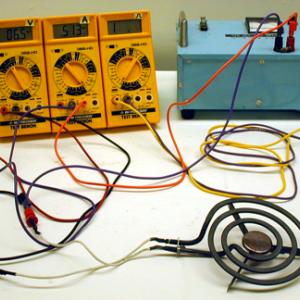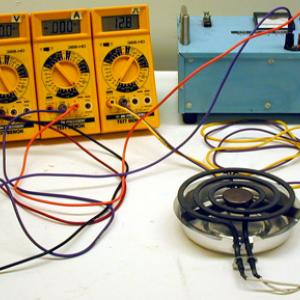College of Liberal Arts & Sciences
5F10.10 - Ohm's Law
Video Credit: Jonathan M. Sullivan-Wood
Hook the resistors or light bulbs into parallel and series pairs. Attach a Multimeter to each type circuit for measuring of voltages or resistances. Use an ammeter and a voltmeter when doing the Ohm's Law demos. Voltage dividers may also be constructed with this equipment.
Ohm's law can also be demonstrated very well with the hot plate heating element. DC voltage is easier to work with when doing this demonstration so use a 0-20 volt or 0-150 volt power supply. Measuring the current, voltage and/or ohms and substituting into the V=IR equation gives you very accurate results. This example can be found in Physics by Cutnell and Johnson Fifth Edition on p. 593.
- Paul Hewitt, "Figuring Physics", TPT, Vol. 60, #8, Nov. 2022, p. 717.
- Jake Stanley Bobowski, "Hydraulic Analogues Illustrating the Charging of a Capacitor and Ohm's Law: Labs for Online Learning Environments", TPT, Vol. 59, #7, Oct. 2021, p. 560.
- "Figuring Physics", TPT, Vol. 50, #2, Feb. 2012, p. 70.
- "Figuring Physics", TPT, Vol. 42, # 4, Apr. 2004, p. 247.
- Art Hovey, "Nomographs", TPT, Vol. 41, #1, Jan 2003, p. 4.
- Kavork Spartalian, "Rectangles in Physics", TPT, Vol. 41, #7, Oct. 2003, p. 390.
- Thomas B. Greenslade Jr., "Additional Reference," TPT, Vol. 41, #7, Oct. 2003, p. 380.
- Pete Vreeland, "Analyzing Simple Circuits", TPT, Vol. 40, #2, Feb. 2002, p. 99.
- Thomas B. Greenslade Jr., "A Nomograph for Resistors in Parallel", TPT, Vol. 40, #8, Nov 2002, p. 458.
- Alison Hapka, "Magnetic Cards for Teaching Electronics", TPT, Vol. 37, #3, Mar. 1999, p. 152.
- Jack Higbie, "Proof of the R-2R Ladder Network", TPT, Vol. 35, #8, Nov. 1997, p. 464.
- Scott F. Rhodes, "A Working Model of Ohm's Law", TPT, Vol. 32, #5, May 1994, p. 319.
- Thomas A. Lehman, "Light on LED's", TPT, Vol. 31, #5, May 1993, p. 262.
- Steven A. Waltner and Thomas A. Lehman, "When Is Ohm's Law Valid?", TPT, Vol. 31, #2, Feb. 1993, p. 102.
- M. H. Ansarizadeh and E. F. Walker, "Solar Approach to Ohm's Law", TPT, Vol. 27, #3, Mar. 1989, p. 217.
- Bernard Scott, "An Intriguing Problem in Equivalent Resistance", TPT, Vol. 26, # 9, p. 578, Dec. 1988.
- Carl H. Hayn, "Ohm's Law Mnemonic", TPT, Vol. 15, #6, Sept. 1977, p. 364, also A Potpourri of Physics Teaching Ideas - Electricity and Magnetism, p. 146.
- M. J. Madsen, "Ohm's Law for a Wire in Contact With a Thermal Reservoir", AJP, Vol. 77, #6, June 2009, p. 516.
- Eo-1, 3, 5, 7: Freier and Anderson, A Demonstration Handbook for Physics.
- E-380: "Simple Circuit", DICK and RAE Physics Demo Notebook.
- David Kutliroff, "89, Ohm's Law as a Demonstration", 101 Classroom Demonstrations and Experiment For Teaching Physics, p. 198.
- Physics, Fifth Edition, Cutnell and Johnson, p. 593.
- Ron Hipschman, "Ohm's Law", Exploratorium Cookbook III, p. 148.1 - 148.3.
- "Ohm's Law in Simple Circuits", Selective Experiments in Physics, CENCO, 1958.
- "Ohm's Law", Selective Experiments in Physics, CENCO, 1942.
- Grant Mellor, "The Squeeze-Bottle Model", Flying Tinsel, 1993, p. 91 - 93.
- Grant Mellor, "A Hot Time", Flying Tinsel, 1993, p. 83 - 87.
Disclaimer: These demonstrations are provided only for illustrative use by persons affiliated with The University of Iowa and only under the direction of a trained instructor or physicist. The University of Iowa is not responsible for demonstrations performed by those using their own equipment or who choose to use this reference material for their own purpose. The demonstrations included here are within the public domain and can be found in materials contained in libraries, bookstores, and through electronic sources. Performing all or any portion of any of these demonstrations, with or without revisions not depicted here entails inherent risks. These risks include, without limitation, bodily injury (and possibly death), including risks to health that may be temporary or permanent and that may exacerbate a pre-existing medical condition; and property loss or damage. Anyone performing any part of these demonstrations, even with revisions, knowingly and voluntarily assumes all risks associated with them.


